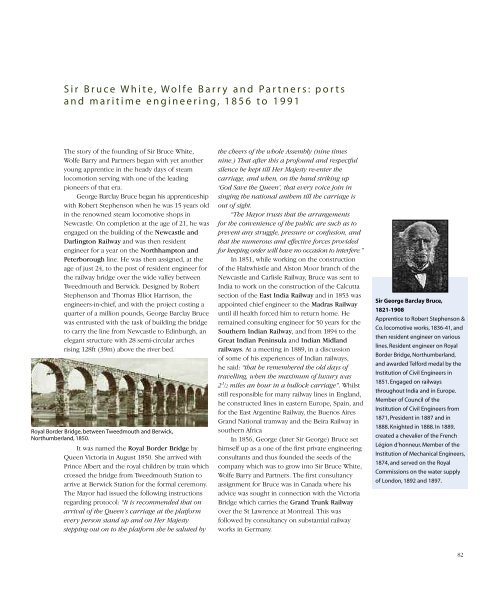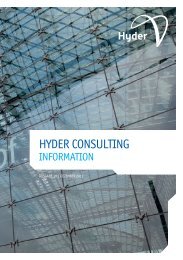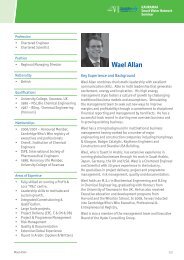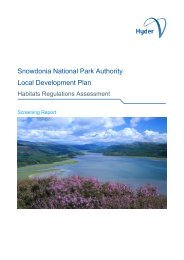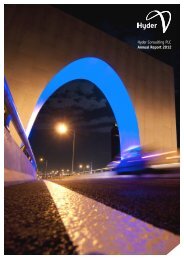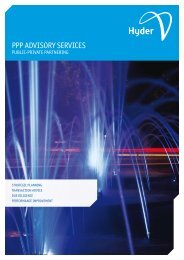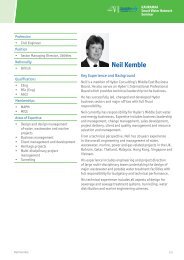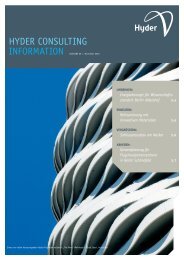John Taylor & Sons - Hyder Consulting
John Taylor & Sons - Hyder Consulting
John Taylor & Sons - Hyder Consulting
Create successful ePaper yourself
Turn your PDF publications into a flip-book with our unique Google optimized e-Paper software.
Sir Bruce White, Wolfe Barry and Partners: ports<br />
and maritime engineering, 1856 to 1991<br />
The story of the founding of Sir Bruce White,<br />
Wolfe Barry and Partners began with yet another<br />
young apprentice in the heady days of steam<br />
locomotion serving with one of the leading<br />
pioneers of that era.<br />
George Barclay Bruce began his apprenticeship<br />
with Robert Stephenson when he was 15 years old<br />
in the renowned steam locomotive shops in<br />
Newcastle. On completion at the age of 21, he was<br />
engaged on the building of the Newcastle and<br />
Darlington Railway and was then resident<br />
engineer for a year on the Northhampton and<br />
Peterborough line. He was then assigned, at the<br />
age of just 24, to the post of resident engineer for<br />
the railway bridge over the wide valley between<br />
Tweedmouth and Berwick. Designed by Robert<br />
Stephenson and Thomas Elliot Harrison, the<br />
engineers-in-chief, and with the project costing a<br />
quarter of a million pounds, George Barclay Bruce<br />
was entrusted with the task of building the bridge<br />
to carry the line from Newcastle to Edinburgh, an<br />
elegant structure with 28 semi-circular arches<br />
rising 128ft (39m) above the river bed.<br />
Royal Border Bridge, between Tweedmouth and Berwick,<br />
Northumberland, 1850.<br />
It was named the Royal Border Bridge by<br />
Queen Victoria in August 1850. She arrived with<br />
Prince Albert and the royal children by train which<br />
crossed the bridge from Tweedmouth Station to<br />
arrive at Berwick Station for the formal ceremony.<br />
The Mayor had issued the following instructions<br />
regarding protocol: “It is recommended that on<br />
arrival of the Queen’s carriage at the platform<br />
every person stand up and on Her Majesty<br />
stepping out on to the platform she be saluted by<br />
the cheers of the whole Assembly (nine times<br />
nine.) That after this a profound and respectful<br />
silence be kept till Her Majesty re-enter the<br />
carriage, and when, on the band striking up<br />
‘God Save the Queen’, that every voice join in<br />
singing the national anthem till the carriage is<br />
out of sight.<br />
“The Mayor trusts that the arrangements<br />
for the convenience of the public are such as to<br />
prevent any struggle, pressure or confusion, and<br />
that the numerous and effective forces provided<br />
for keeping order will have no occasion to interfere.”<br />
In 1851, while working on the construction<br />
of the Haltwhistle and Alston Moor branch of the<br />
Newcastle and Carlisle Railway, Bruce was sent to<br />
India to work on the construction of the Calcutta<br />
section of the East India Railway and in 1853 was<br />
appointed chief engineer to the Madras Railway<br />
until ill health forced him to return home. He<br />
remained consulting engineer for 50 years for the<br />
Southern Indian Railway, and from 1894 to the<br />
Great Indian Peninsula and Indian Midland<br />
railways. At a meeting in 1889, in a discussion<br />
of some of his experiences of Indian railways,<br />
he said: “that he remembered the old days of<br />
travelling, when the maximum of luxury was<br />
2 1 /2 miles an hour in a bullock carriage”. Whilst<br />
still responsible for many railway lines in England,<br />
he constructed lines in eastern Europe, Spain, and<br />
for the East Argentine Railway, the Buenos Aires<br />
Grand National tramway and the Beira Railway in<br />
southern Africa<br />
In 1856, George (later Sir George) Bruce set<br />
himself up as a one of the first private engineering<br />
consultants and thus founded the seeds of the<br />
company which was to grow into Sir Bruce White,<br />
Wolfe Barry and Partners. The first consultancy<br />
assignment for Bruce was in Canada where his<br />
advice was sought in connection with the Victoria<br />
Bridge which carries the Grand Trunk Railway<br />
over the St Lawrence at Montreal. This was<br />
followed by consultancy on substantial railway<br />
works in Germany.<br />
Sir George Barclay Bruce,<br />
1821-1908<br />
Apprentice to Robert Stephenson &<br />
Co. locomotive works, 1836-41, and<br />
then resident engineer on various<br />
lines. Resident engineer on Royal<br />
Border Bridge, Northumberland,<br />
and awarded Telford medal by the<br />
Institution of Civil Engineers in<br />
1851. Engaged on railways<br />
throughout India and in Europe.<br />
Member of Council of the<br />
Institution of Civil Engineers from<br />
1871, President in 1887 and in<br />
1888. Knighted in 1888. In 1889,<br />
created a chevalier of the French<br />
Légion d’honneur. Member of the<br />
Institution of Mechanical Engineers,<br />
1874, and served on the Royal<br />
Commissions on the water supply<br />
of London, 1892 and 1897.<br />
82


